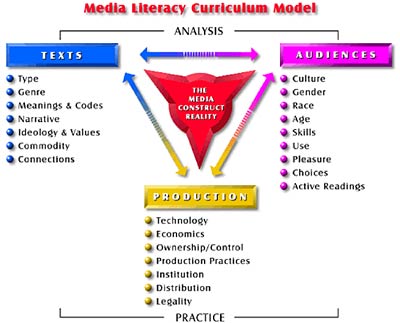Media Literacy FrameworkMedia Literacy Framework
This Media Literacy Curriculum Model is from the critical framework developed by Eddie Dick of the Scottish Film Council.

From the Media Awareness Network
A text is a media product, such as a television program, magazine, book, poster, T-shirt, song etc. We can discuss with students what type of text it is -- cartoon, rock video, fairy tale, police drama, etc. -- and how it differs from other types of text. We can identify how it tells a story, the narrative structure, how meanings are communicated, the values implicit in the text, and connections with other texts. We can also look for stereotypes and point of view to deconstruct the way it communicates.
Anyone who receives a media text is a member of an audience. Modern communication theory teaches that media messages are targeted to specific audiences and audiences "negotiate" meaning. Each individual reader of a text will draw from its range of possible meanings, a particular reading that reflects that individual's gender, race or cultural background, social class and age, etc. Thus the "meaning" of a text is not something determined by critics, teachers or even authors, but is determined in a dynamic and changeable relationship between the reader and the text.
Production refers to everything that goes into the making of a media text -- the technology, the ownership and economics, the institutions involved, the legal issues, the use of common codes and practices, the roles in the production process. It is important to keep in focus the relationship between the various aspects of production, and the other two broad areas of text and audience. Who produced this text and for what purpose? How are values related to ownership and control? How does technology determine what we will see? How does the cost of technology determine who can make media productions?
Understanding in these areas is best developed through the students' involvement in their own production work.